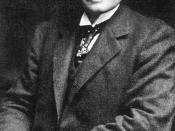Fredrick Taylor, the father of scientific management. He had a firm belief in "one best way" (Samson & Daft, 2003), of doing something. In the year 1899, Taylor held an experiment that involved German and Hungarian men, whose job involved some very heavy-duty work (Gabor, 2000). To his disappointment, men either refused to work, or wouldn't work to his expectations. The men hated him utterly; to the extent he required security when going home (Gabor, 2000). In his entire dilemma with his employers, in stepped Schmidt, a man not of intelligence but had the strength of a bull and an ox-like mentally required to reach the standards of Fredrick Taylor. The story of Schmidt reflected 2 two significant aspects of Taylorism (Gabor, 2000). Firstly, it reflected his aggressive personality, which included his high expectation in people, hence his drive to keep on improving. Secondly, it reflected how he did not understand nor respect the limits of a human being, revealed in his strict and precise managerial style.
Scholars of all times seem to criticise this aspect of Taylorism, but despite its deficiency, scientific management soared into the 20th century and remains relevant to today's organisations. Scientific management has its shortcomings and in some instances not relevant in today's organisations.
Its relevance to today's organisations is simply the fact that it worked and continues to today. The system had a strict and clear-cut methodical approach. That was because of Taylor's firm belief that there was one best way. His view of the management's role was to decide exactly how a task was to be performed and that they were to determine how this would be done (Crainer, 1999). His idea of finding the one best way was the use of a stopwatch and timing the process of doing a...


